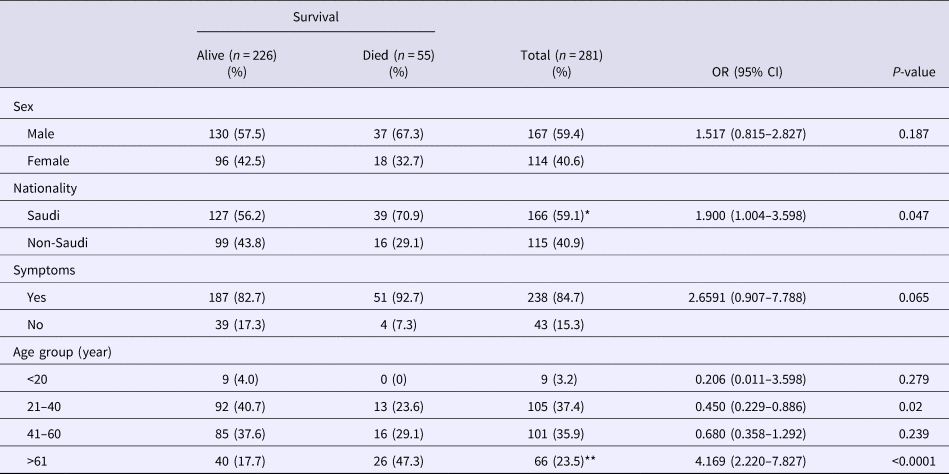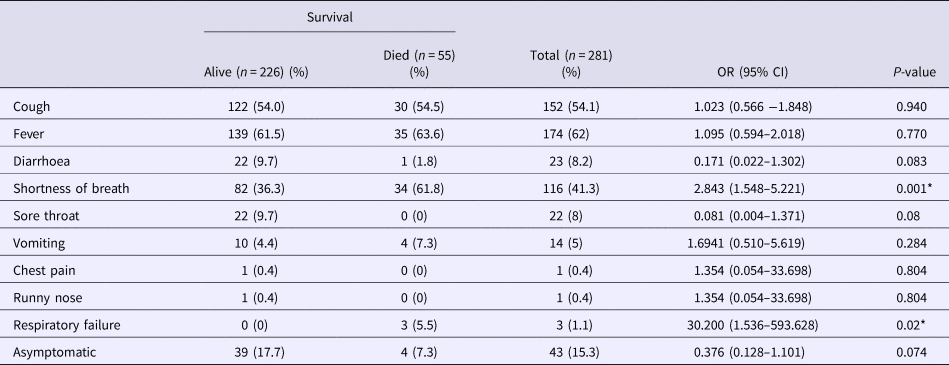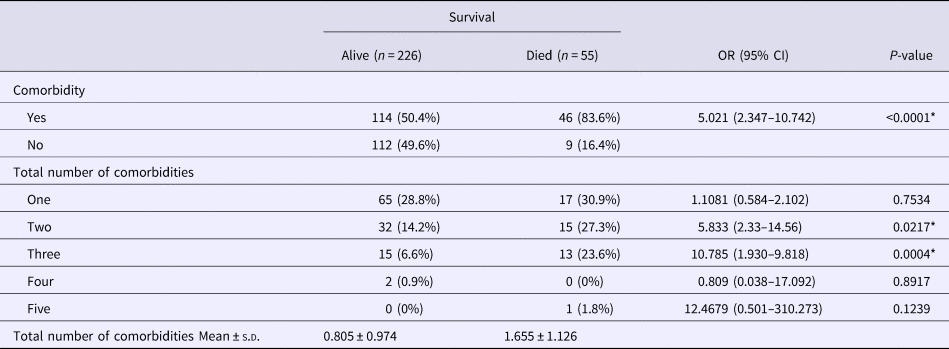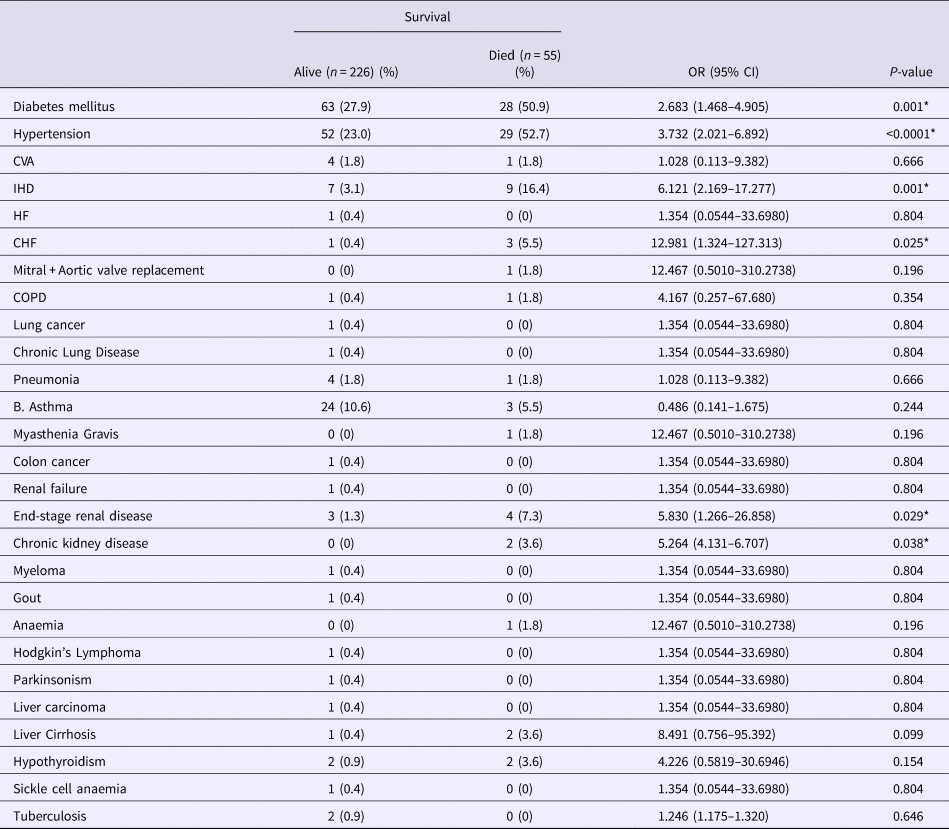Introduction
The first case of Middle East respiratory syndrome coronavirus (MERS-CoV) was reported in Saudi Arabia in 2012 and the novel causative virus, MERS-CoV, was identified [Reference Zaki1, Reference de Groot2]. To date, 2040 laboratory-confirmed cases of MERS-CoV infection have been reported to the World Health Organization [3] from 27 countries [3]. Most reported cases were from countries in the Middle East, among which 82% occurred in Saudi Arabia; other cases were reported from North Africa, Europe, the USA and East Asia, with the latter cases involving individuals who had travelled to the Middle East [3]. Owing to the high mortality rate and the lack of antiviral treatment or a preventative vaccine, MERS-CoV remains a major public health concern.
Coronaviruses are enveloped, positive-sense, single-stranded RNA viruses that belong to the subfamily Coronavirinae within the Nidovirales order, which are further subdivided into four genera: alpha, beta, gamma and delta. Human coronaviruses belong to the alpha and beta genera [Reference Chan4].
Phylogenetically, MERS-CoV belongs to the beta coronavirus lineage C, with a genotype that is very closely associated with bat coronaviruses from the same lineage, such as BtCoV-HKU4 and BtCoV-HKU5 [Reference van Boheemen5]. MERS-CoV is considered as a zoonotic virus that can cause secondary infections in humans. While dromedary camels were recognized as the intermediate host of MERS-CoV, human-to-human transmission has been observed in community clusters [Reference Cotten6–Reference Memish9], among hospital contacts [Reference Assiri10, Reference Guery11] and among healthcare workers [Reference Guery11], which raises concerns regarding its pandemic risk [Reference Guery11].
MERS-CoV is more prevalent in males [3, Reference Assiri10, Reference Arabi12, Reference Assiri13] and has a clinical spectrum ranging from asymptomatic to life-threatening, which includes acute respiratory distress syndrome, pneumonia, myocarditis and organ failure [Reference Assiri10, Reference Arabi12, Reference Assiri13]. The case fatality rate of MERS-CoV ranges from 30% to 60% [Reference Assiri13–Reference Rivers, Majumder and Lofgren17], in which severe disease presentation is correlated with pre-existing medical conditions such as diabetes, cardiovascular diseases, renal failure, obesity and immunodeficiency [Reference Assiri13, Reference Al-Tawfiq18]. Thus, the present paper aims to investigate the effect of comorbidities on the mortality rate of confirmed MERS-CoV cases in Saudi Arabia.
Methods
Data collection
All laboratory-confirmed MERS-CoV cases reported by the Saudi Ministry of Health to WHO between 23 April 2014 and 7 June 2016 were identified. Patient charts were reviewed for demographic information, mortality, comorbidities and clinical presentation.
Case definition
A suspected case was defined as any instance of hospitalization for bilateral pneumonia and any one of the following clinical symptoms at admission: fever (>38 °C), cough, shortness of breath (SOB), sore throat, vomiting, diarrhoea, haemoptysis, chest pain and/or infection, respiratory failure, loss of consciousness, runny nose and any asymptomatic cases with a history of contact with confirmed symptomatic cases.
A confirmed case was a suspected case with a laboratory-confirmed MERS-CoV infection on the basis of positive real-time polymerase chain reaction (RT-PCR) results for MERS-CoV in swab samples collected by the Ministry of Health. Signed informed consent was obtained from patients or the legal guardians of minors for the use of their (coded) data for research purposes.
Asymptomatic cases were those with no reported symptoms at the time of a positive test recorded by a healthcare provider in the medical chart. However, these patients showed symptoms subsequently in the clinical course. In contrast, in symptomatic cases, patients reported their symptoms during hospital admission.
Molecular testing
All RT-PCR tests were performed at the Saudi Ministry of Health MERS-CoV regional laboratory in Riyadh. Respiratory samples were obtained from all patients and were submitted to the regional laboratory for testing using primers that amplify both the upstream E protein (upE) and ORF1a genes. Samples that tested positive for both upE and ORF1a gene targets were considered as confirmed cases. Each patient was tested at least twice and each test was conducted on a different day.
Statistical analyses
Statistical analyses were performed for determining significant differences using t tests, the χ 2 test and Fisher's exact test where appropriate. The odds ratio (OR) and 95% confidence interval (CI) were obtained for each variable. Statistical analyses were performed using SPSS, version 21 software (IBM Corp., Armonk, NY, USA). A P-value < 0.05 was considered statistically significant.
Results
A total of 281 confirmed MERS-CoV cases from Saudi Arabia were reported to the Saudi Ministry of Health from 23 April 2014 to 7 June 2016. Table 1 shows the distribution of the cases by sex, age, nationality, symptoms and fatality rates. The ratio of male to female cases was 1.45:1. Of the 281 confirmed cases, 55 (20%) died and the case fatality rate was higher in males than females, even though this difference was not statistically significant (67.3% vs. 32.7%; OR: 1.5, 95% CI 0.81–2.83; P = 0.221). Death predominantly occurred in Saudi citizens (P = 0.047) and in the group aged older than 60 years (P < 0.0001). The most prevalent clinical symptoms included fever (62%) and cough (54.1%), followed by SOB (41.3%; Table 2). Death among laboratory-confirmed cases of MERS-COV infection was significantly associated with a SOB and respiratory failure (P < 0.001 and P < 0.007, respectively; Table 2).
Table 1. Mortality in Middle East respiratory syndrome coronavirus confirmed cases in Saudi Arabia between 23 April 2014 and 7 June 2016

Data presented as n (%).
Table 2. Symptoms of Middle East respiratory syndrome coronavirus in confirmed cases at presentation

*Significant p value.
Among the 281 cases, 160 (56.9%) patients had underlying comorbid conditions (Table 3).
Table 3. Number of comorbidities in relation to mortality from Middle East respiratory syndrome coronavirus infection

*Significant p value.
Patients with comorbidities had a higher mortality risk compared with those without (83.6% vs. 16.4%, P < 0.0001). The number of comorbidities in relation to mortality is shown in Table 4. Diabetes mellitus (DM), hypertension (HTN), cardiac diseases, renal disease and bronchial asthma were the most frequent comorbid disorders (Table 4). Among the comorbidities, DM, HTN, ischemic heart disease (IHD), congestive heart failure (CHF), end-stage renal disease (ESRD) and chronic kidney disease (CKD) showed significant associations with fatality from MERS-CoV (OR 2.6 (1.4–4.9), OR 3.7 (2.02–6.9), OR 6.1 (2.1–17.2), OR 12.9 (1.3–127.3), OR 5.8 (1.2–26.8) and OR 5.2 (4.1–6.7), respectively; Table 4). In this regard, the prevalence of death in diabetic and hypertensive patients was similar (28 (50.9%) and 29 (52.7%)), respectively. Further analysis of those patients who had these comorbidities including DM, HTN, IHD, CHF, ESRD and CKD that contributed significantly to mortality from MERS-CoV showed no significant difference in mortality (P > 0.05) between symptomatic and asymptomatic groups (data not shown). Moreover, only four cases of asymptomatic patients died representing 1% of total 281 cases, three of these four were elderly aged more than 66-years-old with comorbidities (HTN and/or dementia) and one case aged 55-years-old and had additional multiple comorbidities (DM, HTN, COPD). Taking as presented in Table 4, the presence of two or three comorbidities significantly increased the risk of death from MERS-CoV infection (P < 0.0001).
Table 4. Comorbidities in confirmed cases of Middle East respiratory syndrome

*Significant p value.
Discussion
In the present study, the mortality rate was 20% among the 281 confirmed cases of MERS-CoV infection in Saudi Arabia between 23 April 2014 and 7 June 2016. Mortality was higher in male patients, with a male-to-female ratio of 1.45:1. The predominance of male cases is consistent with the findings reported in previous studies in Saudi Arabia and South Korea [Reference Chen19, Reference Bermingham20], which may be associated with cultural or occupational behaviours in males that increase the risk of infection. Saudi citizens showed significantly higher mortality than non-Saudi citizens. The demographic features of the laboratory-confirmed cases of MERS-COV infection in the current study showed that only nine patients were aged <20 years; 73.2% were aged 21–60 years and 23.5% were aged >61 years. These findings are in agreement with those of previous studies reported in Saudi Arabia [Reference Cauchemez14, Reference Cauchemez21–Reference Aleanizy23]. In addition, the higher mortality rate among elderly patients (>61 years) is consistent with the rate reported in a previous study [Reference Al-Shehri24]. A possible explanation for this may be age-associated immunosenescence, which results in a suboptimal immune response in these individuals following exposure to MERS-CoV [Reference Aly25] and the possible interference of underlying comorbidities in elderly patients cannot be ruled out. The clinical presentations of MERS-CoV cases observed in this study have similar symptomatology and frequency to those previously reported [Reference Assiri10, Reference Assiri13, Reference Al-Tawfiq18]. Remarkably, among the noted symptoms, SOB and respiratory failure were significantly associated with higher mortality.
In this study, chronic conditions such as DM, HTN, IHD, CHF and renal disease significantly influenced the severity of MERS-CoV. The observed increase in the mortality rate in MERS-CoV patients with underlying chronic conditions corroborates the findings of earlier studies in Saudi Arabia [Reference Assiri13, Reference Al-Tawfiq18]. This is also in line with the findings for other respiratory diseases such as influenza [Reference Mertz26], influenza A H1N1 [Reference Kusznierz27, Reference Suryaprasad28] and SARS [Reference Moni and Lio29]. A recent study found that obesity, cardiovascular, hypertension and neuromuscular disease were strongly associated with severe pandemic influenza [Reference Mertz26]. In SARS, comorbidities such as immunological, neurological, metabolic and dermatologic diseases were strongly associated with the disease [Reference Moni and Lio29]. These conditions are known to weaken the host's innate and humoral immune systems, thereby limiting their ability to counteract any new infection [Reference Park30].
The present study has some limitations. First, although all confirmed MERS-CoV cases were notified to the Saudi Ministry of Health from different regions and hospitals in Saudi Arabia. However, we cannot rule out the possibility that some cases have gone undetected. Second, comorbidity data for admissions without MERS-CoV infection were unavailable.
In conclusion, the present study has shown that old age and the presence of comorbidities are associated with adverse outcomes in MERS-CoV patients, including increased mortality rates.
Acknowledgments
The authors extend their appreciation to Research Centre of the Science and Medical studies Departments at King Saud University for funding this study.
Conflict of interest
The authors declare no conflict of interest.






